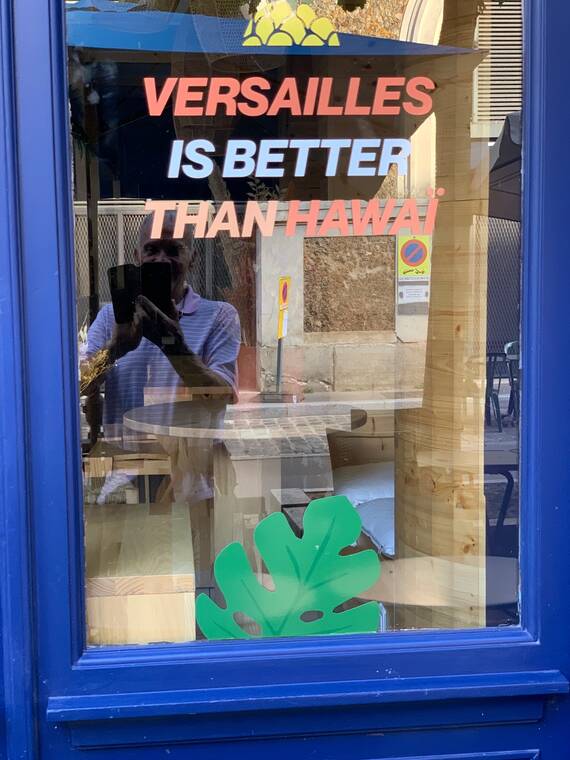We are traveling in Europe and seeing the effects of climate change. Record heat, fires and the other extreme of floods make us mindful of our little bit of Paradise, Hawaii.
Environmental protection, native species, global warming, air quality and industrial pollution are popular topics in almost anyone’s conversation these days. We are concerned about protection of our islands’ air, soil and water, our forests, seashores, rivers and wildlife. However, talking about protecting our environment is kind of like talking about the weather. Most people figure they can do little about it as individuals. Nothing could be further from the truth. As individuals, we can be conservationists right in our own gardens and communities. We can plant native trees and shrubs. We can also plant to encourage desirable wildlife at higher elevations like our native honeycreepers. We can also encourage nonnatives like cardinals, doves and finches in urban neighborhoods just to mention a few.
Trees and other forest plants are vital for Hawaii’s wildlife. All animals, including man, owe their existence to vegetation of one kind or another. With much of our lands being developed, it’s important to encourage vegetation in abundance since the oxygen we breathe is provided by plants.
Here in Hawaii, we have a wide variety of plants, both native and introduced. Therefore, we have a wide variety for beauty and food sources for animals such as birds. By keeping the lush vegetation an integral part of our communities, we actually do our part to fight pollution and make life more enjoyable. There are a number of trees that can help accomplish this purpose. Among the best are palms, the native Pritchardia species and many other exotics like Livistonas, Royals, King and Queen palms. When planted, they will attract countless birds as the seeds ripen. Other plants, such as sea grape and the native naupaka, are attractive to many birds and also make good ornamentals for a lowland garden. Natives like the Ohia, Hau, Milo, Hibiscus and Mamane may even attract some nectar feeding birds.
When collecting seeds or plants in the wild, it is best to transplant only smaller specimens. Be sure to get trees with plenty of roots and to keep them moist all the time. All in all, it usually pays to buy good nursery grown specimens when available rather than try to transplant from the forest. You have to be careful not to spread rapid ohia death by taking Ohia plants.
The Hala tree is another native of interest and beauty.
Lauhala, or leaf of the Pandanus plant, has probably been used for thousands of years by the Polynesians. Not only are the leaves used for walls, floor mats, and thatch roof but modern Polynesians weave purses, shopping bags and hats. Even the fruit, which resembles a pineapple, was eaten during periods of food shortage. Today, island campers will use the fibrous segments as a toothbrush.
The Pandanus family, closely related to palms, is found throughout the old world tropics. There are hundreds of species, from miniature shrubs to large trees. Most species can be easily distinguished by their aerial roots. These roots give them the common name of “walking trees.”
Here in Hawaii, we have two common native species; Puhala or Pandanus odoratissimus, which is found along many coastal areas, and the mountain ie‘ie or Freycinetia Arnotti. This plant is found climbing vine-like up ohia trees in mauka forests, sometimes to 80 feet or more. Although common in some rainforest and cloud forest areas, it is difficult to transplant or grow from cuttings. Therefore it is seldom available in local nurseries. Unfortunately, when folks buy property where ie‘ie is present, they often don’t realize it is a native and will remove it.
Then there are the plants the Polynesians carried as they migrated from one island to another in the tropical Pacific. These are referred to as “canoe plants” and include banana, taro, breadfruit, some gingers, sweet potato, bamboo and many others. Canoe plants can definitely add to your garden and even reduce your grocery bill.
By creating urban forests in our communities, we actually help reduce the amount of carbon dioxide and pollutants that contribute to global warming.
We can also encourage large ranches to take some of the of the pasture land and replant our forests. There are tax advantages and even opportunities for landowners, developers and industries that have large carbon footprints to benefit financially by getting involved in carbon sequestering programs.
This summer has been one of the hottest on record on the mainland. Even if we forget all the other benefits of plants, we should consider their cooling effect.
Recently, one of our local parking lots in Kailua-Kona, in the Old Industrial Area, there were large monkeypods keeping the temperatures in the low 80s. The trees were cut down and now with no shade trees the exposed paving had a temperature recorded of 120 degrees. Large expanses of highway with no shade trees add to the sweltering heat experienced in many urban areas. We need to encourage our local and state elected officials to support programs that emphasize urban planting. Wouldn’t it be great if our County Council and state legislature included this among their future top priorities!






